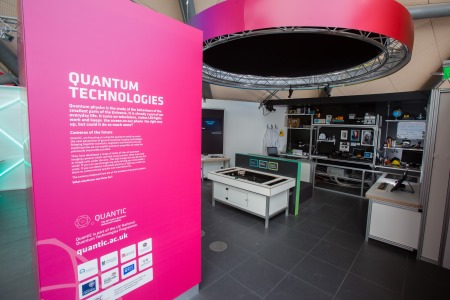Tech from the future arrives in Scotland
Published: 29 April 2016
The first quantum technology exhibition of its kind is launched at the Glasgow Science Centre
Visitors to Glasgow Science Centre will be the first in the UK to play with quantum imaging technology which in future will help us see round corners and make the invisible visible.
The scientists behind the exhibition -the first of its kind in the UK - believe the “future tech”, which will be on display from Friday 29 April for two years, could help prevent car crashes, allow doctors to see through patients’ skin and detect gas leaks using mobile phones.
Quantum technology exhibition launches at GSC
The exhibits, designed by the Glasgow Science Centre, bring to life some of the research being done by QuantIC - the UK Hub for Quantum Enhanced Imaging. The Hub is part of the UK National Quantum Technologies Programme which has received £270 million in government funding to spearhead the translation of quantum technologies from laboratory to industry to benefit the UK economy. QuantIC aims to revolutionise imaging and sensing technology to offer new and innovative applications and competitive advantages to benefit industry.
The exhibition explores quantum physics, the study of the Universe at its smallest level where the rules of classical physics do not apply; for example particles being in more than one location at the same time.
The exhibition is made up of a number of exhibits including:
Light in flight
The light-in-flight camera can capture an image of light as it is moving. In the future this could be used to see an object around a corner by capturing individual light particles, known as photons, as they bounce off an object. The light-in-flight camera could be installed on cars to detect other vehicles or pedestrians coming round blind corners and preventing car crashes or used in search-and-rescue missions to allow emergency services to see round corners into rooms to locate people, even if they are moving.
Single pixel camera
The single-pixel camera can capture an image of gas, and see through smoke, tinted glass and paint. This new type of camera replaces the millions of pixels found in a conventional camera with just one detector, which works with a set of mirrors to reflect a pattern of light from an object onto the detector which a computer then turns into an image. This technology will be very cheap which will mean it could offer competitive advantages over a more expensive infrared camera.
Mid-Infrared and terahertz section
The mid-infrared and terahertz section of the exhibition looks at the adaptations QuantIC has made to materials which will allow cheap and portable mid-infrared cameras to be developed which could check if crops are healthy. A practical use of the terahertz camera would be to allow doctors to see through skin without causing damage.
Dr Stephen Breslin, Chief Executive of Glasgow Science Centre said: “The work being done by quantum physicists will change all of our everyday lives, making us safer and healthier, and will provide us with smarter technology. The QuantIC exhibition at Glasgow Science Centre is providing a window on the most advanced research being carried out in the UK.
“Our team of scientists and designers has worked closely with QuantIC to ensure that the complex science behind quantum physics is interpreted in our exhibition so that it is understandable and relevant to everyday lives.
“We are very excited to be amongst the first to be able to bring this technology to the public and hope the exhibition will inspire a new wave of quantum physicists to help take forward this cutting edge work to discover the field’s full potential for the benefit of mankind.”
Professor Miles Padgett, Principal Investigator of QuantIC, added: “QuantIC is thrilled to have been able to work with the Glasgow Science Centre team to develop an exhibition that introduces both quantum physics and our own research to the public. We are also inviting visitors to give us suggestions on what they think our technology could be used for, via social media using the hashtag #askquantic. Who knows, the super application for our Quantum Cameras could only be a tweet away.”
First published: 29 April 2016
<< May

